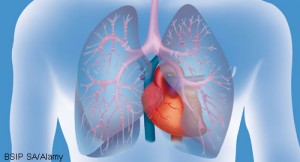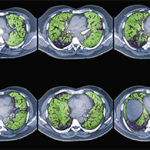 ORLANDO—Interstitial lung disease (ILD)—our patients get it. We need to know about it, and often we need to treat it. But ILD is a large alphabet soup of radiographic patterns, and most of us didn’t complete training in pulmonology and radiology.
ORLANDO—Interstitial lung disease (ILD)—our patients get it. We need to know about it, and often we need to treat it. But ILD is a large alphabet soup of radiographic patterns, and most of us didn’t complete training in pulmonology and radiology.
At the 2022 ACR Education Exchange, April 28–May 1, a cardiothoracic radiologist shared high-yield tips for ordering and interpreting chest computed tomography (CT).
‘What Kind of CT?’
Adam Guttentag, MD, associate professor of clinical radiology and radiologic sciences, Vanderbilt University Medical Center, Nashville, began his talk with the basics of chest CT imaging. “The type of CT you order depends on what questions you want answered,” he said. “Before, the only way to get thin sections was to order a high-resolution CT [HRCT]. But at many hospitals now, standard CT chests are thin section and aren’t ‘low resolution,’ as the names suggest.”
For known or suspected ILD, HRCT is best. “Think of HRCT as the ILD scan. It’s a specific protocol for ILD that should be used for the initial evaluation of ILD to get the best sense and description of the disease,” Dr. Guttentag said.
HRCT often involves standard CT sequences, plus two additional sequences: expiratory images that assess for air trapping and prone images that help clear out the dependent lung bases and confirm disease is truly present.
“Images can appear abnormal in [posterior lung fields] if the patient isn’t taking a deep breath on the supine film,” Dr. Guttentag said. “When it comes to follow-up scans for people with known ILD, HRCT is not necessary as long as your radiologist uses thin sections on standard CT.”
What about intravenous (IV) contrast? Dr. Guttentag explained that IV contrast does not help diagnose ILD or find nodules. It’s most useful for measuring adenopathy in the mediastinum and hila, and separating pleural from pulmonary disease. It can also help us see large vessel vasculitis, but a CT angiogram protocol is preferred for that.
“Don’t ever order a CT chest with and without contrast unless you’ve spoken to radiology and there’s a good reason for it. It just doubles the radiation dose,” said Dr. Guttentag.
Interpretation
CT images may seem intimidating. But reviewing the images in addition to the radiologist’s report is better medicine. Dr. Guttentag broke down his approach into three steps: distribution, dominant pattern and clinical information.


